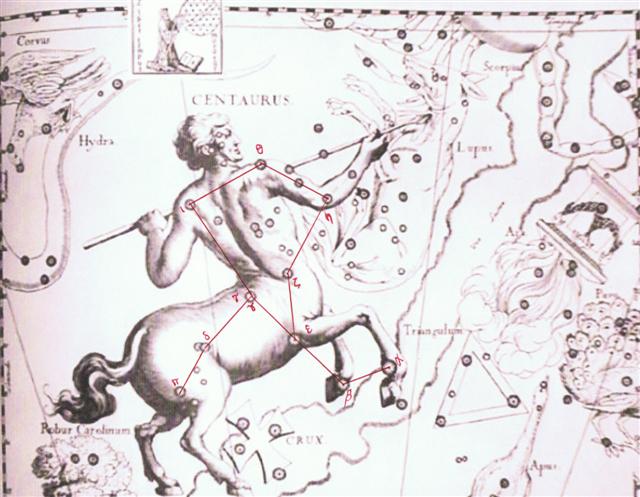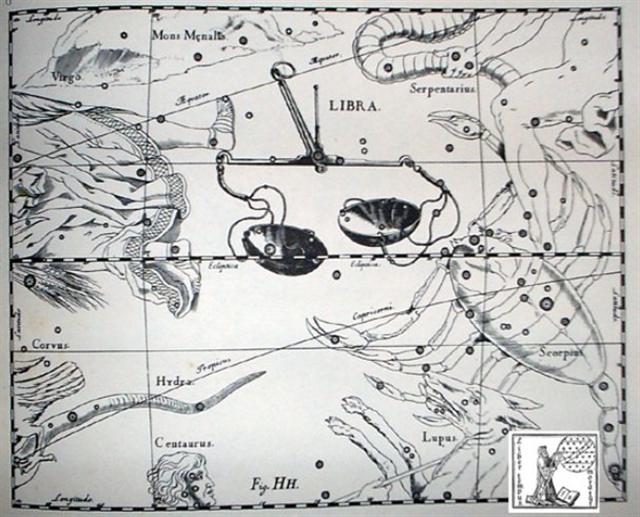Day 384 counted from 0h in the
Mamari text (*Ca14-21), April 8 (464), was a day
when time evidently was divided into a past and a
future, visualized as a glyph with 2 halves. 13 *
29½ = 383½ = 201 + 365 / 2. Between σ Virginis
and Spica was ι Centauri, at the left shoulder of
the 'Cavalry Officer':
| April 5 |
6 |
7 |
8 |
9 (465) |
10 (100) |
 |
 |
 |
 |
 |
 |
| *Ca14-18 |
*Ca14-19 |
*Ca14-20 |
*Ca14-21 (384) |
*Ca14-22 |
*Ca14-23 |
| te honu paka |
te henua |
honu kau |
te mata |
te honu |
kua heheu |
| 1h (15.2) |
Al Batn Al Hūt-26 / Revati-28 |
ν Phoenicis (17.4), κ Tucanae (17.6) |
no star listed (18) |
Adhil (19.3) |
Ksora (20.1), ω Andromedae (20.6), γ Phoenicis (20.8) |
| β Phoenicis (15.1), υ Phoenicis, ι Tucanae (15.6), ζ Phoenicis (15.7) |
MIRACH, Keun Nan Mun (16.0), Anunitum (16.5), REVATI (16.9)
Regulus
|
| Apami-Atsa, ψ Hydrae (198.5) |
Al Dafīrah (199.4) |
σ Virginis (200.4) |
γ Hydrae (201.0), ι Centauri (201.4) |
Al Simāk-12 / Chitra-14 / Horn-1 / Sa-Sha-Shirū-20 ANA-ROTO |
71 Virginis (203.6) |
| Mizar (202.4), SPICA, Alcor (202.7)
Sadalmelik
|

Mizar (ζ) and Alcor (80) were rising in the same day as Spica:

Possibly 71 Virginis at the beginning of the 'primal mound' (Mons Menalis) influenced the design of *Ca14-23, with the new beginning hidden under the earth (te nuku):
... Ta'aroa tahi tumu, 'Ta'aroa origl. stock' - most commonly Ta'aroa or Te Tumu - existed before everything except of a rock (Te Papa) which he compressed and begat a daughter (Ahuone) that is Vegetable Mole.*
* Ahuone means 'earth heaped up' - a widespread name for the Polynesian first woman. It sounds as if Cook also heard the term applied to the banks of humus and rotting material on which taro is grown. In the English of his day this was known as 'vegetable mould' ...

In G the same day (April 8, 464) should also be divided, but this cannot be read from the glyphs:
 |
 |
 |
 |
 |
 |
 |
| Ga5-22 |
Ga5-23 |
Ga5-24 |
Ga5-25 |
Ga5-26 (136) |
Ga5-27 |
Ga5-28 |
| JULY 31 |
AUGUST 1 |
2 |
3 |
4 (216) |
5 |
6 |
| δ Muscae (196.5), Vindemiatrix (196.8) |
13h (197.8) |
Apami-Atsa, ψ Hydrae (198.5) |
Al Dafīrah (199.4) |
σ Virginis (200.4) |
γ Hydrae (201.0), ι Centauri (201.4) |
Al Simāk-12 / Chitra-14 / Horn-1 / Sa-Sha-Shirū-20
ANA-ROTO |
| ξ¹ Centauri (197.1), ξ² Centauri (197.9) |
Mizar (202.4), SPICA, Alcor (202.7)
Sadalmelik
|
| October 3 |
4 |
5 |
6 |
7 (280) |
8 |
9 |
| NAKSHATRA DATES: |
| JANUARY 30 |
31 |
FEBRUARY 1 |
2 |
3 (399) |
4 |
5 (36) |
| no star listed (14) |
1h (15.2) |
Al Batn Al Hūt-26 / Revati-28 |
ν Phoenicis (17.4), κ Tucanae (17.6) |
no star listed (383 - 365) |
Adhil (19.3) |
Ksora (20.1), ω Andromedae (20.6), γ Phoenicis (20.8) |
| β Phoenicis (15.1), υ Phoenicis, ι Tucanae (15.6), ζ Phoenicis (15.7) |
MIRACH, Keun Nan Mun (16.0), Anunitum (16.5), REVATI (16.9)
Regulus
|
| April 4 |
5 |
6 |
7 |
8 |
9 |
10 (100) |
Instead we can see how a head has disappeared in front in January 18 (383), i.e. 80 days earlier than April 8 (or 285 days later). It could mean time was measured from 0h in the Mamari (Egg) text but from January 1 in the G text:
|
96 |
 |
 |
 |
|
Gb1-6 (235) |
Gb1-7 |
Gb1-8 |
|
NOVEMBER 11 |
12 (316) |
13 |
|
υ Aquilae (299.1),
Tarazed
(299.3), δ Sagittae (299.6), π Aquilae
(299.9) |
Sravana-23 |
ι Sagittarii (301.2), Terebellum, ξ Aquilae
(301.3),
Alshain
(301.6), φ Aquilae (301.8) |
|
ζ Sagittae (300.1),
ALTAIR
(300.3), ο Aquilae (300.5), Bezek (300.8) |
|
January
14 |
15 (380) |
16 |
|
NAKSHATRA DATES: |
|
MAY
13 (133) |
14 (499) |
15 (135) |
|
Azmidiske
(117.4) |
φ Gemini (118.4) |
Drus (119.9) |
|
July 16 |
17 (198) |
18 (564) |
 |
 |
 |
 |
 |
|
Gb1-9 |
Gb1-10 |
Gb1-11 (240) |
Gb1-12 |
Gb1-13 |
|
NOVEMBER 14 |
15 |
16 (320) |
17 |
18 |
|
ε Pavonis, θ Sagittarii (302.3), γ Sagittae
(302.5), μ Pavonis (302.7) |
τ Aquilae
(303.8) |
20h (304.4) |
Shang Wei (305.2), θ Sagittae (305.4),
Tseen Foo (305.6), ξ Capricorni (305.8) |
Tso Ke (306.3) |
|
η Sagittae (304.2), δ Pavonis (304.4) |
|
January
17 |
18 (383) |
19 |
20 |
21 |
|
NAKSHATRA DATES: |
|
MAY
16 (136) |
17 |
18 |
19 (504) |
20 |
|
ω Cancri (120.2) |
8h (121.7) |
ρ Puppis (122.0), Heap of Fuel
(122.1), ζ Monocerotis (122.3),
ψ Cancri (122.6), Regor (122.7) |
Tegmine (123.3) |
Al Tarf (124.3)
Ras
Algethi |
|
χ Gemini (121.0),
Naos (121.3) |
|
July
19 (200) |
20 (566) |
21 |
22 |
23 |
January 18 (383) - 80 = 303 days
counted from 0h = 200 (σ Virginis) + 103
and 303 counted from 0h + 80 = 383 (1-18). 118 =
472 / 4.
In January 18
τ Aquilae rose with the Sun and
13 synodic lunar months after January 1 in the
previous year could have been the time for the Eagle
to lift up the Dead Man.
At the opposite side of the year
could then be his station of birth, probably calibrated to fit also
with the calendar of Julius Caesar. Nakshatra
Gredi (α
Capricorni) was at manu kake (the
climbing bird) at the beginning of line Ga3:
 |
 |
 |
 |
 |
 |
 |
| Ga2-24 |
Ga2-25 |
Ga2-26 (56) |
Ga2-27 |
Ga2-28 |
Ga2-29 |
Ga3-1 |
|
MAY
14 |
15 |
16 |
17 (137) |
18 |
19 |
20 |
| φ Gemini (118.4) |
Drus (119.9) |
ω Cancri (120.2) |
8h (121.7) |
ρ Puppis (122.0), Heap of Fuel (122.1), ζ Monocerotis (122.3), ψ Cancri (122.6), Regor (122.7) |
Tegmine (123.3) |
Al Tarf (124.3)
Ras Algethi
|
| χ Gemini (121.0), Naos (121.3) |
| July 17 |
18 |
19 (200) |
20 |
21 |
22 |
23 |
| 'June 20 (*91) |
SOLSTICE |
22 |
23 |
St John's Eve |
25 |
26 |
|
NAKSHATRA DATES: |
| NOVEMBER 13 |
14 |
15 |
16 (320) |
17 |
18 |
18 |
| ι Sagittarii (301.2), Terebellum, ξ Aquilae (301.3), Alshain (301.6), φ Aquilae (301.8) |
ε Pavonis, θ Sagittarii (302.3), γ Sagittae (302.5), μ Pavonis (302.7) |
τ Aquilae (303.8) |
20h (304.4) |
Shang Wei (305.2), θ Sagittae (305.4), Tseen Foo (305.6), ξ Capricorni (305.8) |
Tso Ke (306.3) |
Gredi (307.2), σ Capricorni (307.5), Alshat (307.9) |
| η Sagittae (304.2), δ Pavonis (304.4) |
| January 16 |
17 |
18 (383) |
19 |
20 |
21 |
22 |
| 'December 20 |
SOLSTICE |
22 |
23 (*277) |
Christmas Eve |
25 |
26 |
The solstices at the time of rongorongo were 27 glyphs earlier in the text, with the Head gone away in Ga1-29:
 |
 |
| Ga1-30 |
Ga2-1 |
| APRIL 20 |
21 (111 = 175 - 64) |
| Furud (94.9) |
Well-22 |
| δ Columbae (95.2), TEJAT POSTERIOR, Mirzam (95.4), CANOPUS (95.6), ε Monocerotis (95.7), ψ1 Aurigae (95.9) |
| June 23 (6 * 29 = 174) |
St John's Eve |
| 'May 27 |
28 (148) |
|
NAKSHATRA DATES: |
| OCTOBER 20 |
21 (294 = 111 + 183) |
| Purva Ashadha-20 |
| KAUS MEDIUS, κ Lyrae (277.5), Tung Hae (277.7) |
KAUS AUSTRALIS (278.3), ξ Pavonis (278.4), Al Athfar (278.6) |
| December 23 (*277) |
Christmas Eve |
| 'October 26 (330) |
27 |
What a marvellous game! We should also remember the similarity between Ga2-26 and Cb4-20:
 |
 |
 |
 |
| Cb4-17 (480) |
Cb4-18 |
Cb4-19 |
Cb4-20 |
| erua marama |
tagata noho i to mea |
kua vaha |
|
MAY
10 (130 = 480 - 350) |
11 |
12 |
13 |
| July 13 |
14 |
15 (180 + 16) |
16 |
| 'June 16 |
17 (168) |
18 |
19 |
| ANA-TAHUA-VAHINE-O-TOA-TE-MANAVA |
α Monocerotis (115.4), σ Gemini (115.7) |
κ Gemini (116.1), POLLUX (116.2), π Gemini (116.9) |
Azmidiske (117.4) |
| υ Gemini (114.0), Markab Puppis (114.7), ο Gemini (114.8), PROCYON (114.9) |
|
NAKSHATRA DATES: |
| NOVEMBER 9 (313) |
π |
11 |
12 |
| January 12 |
13 (378) |
14 |
15 |
| 'December 16 (350) |
17 |
18 |
19 |
| ε Sagittae (297.1), σ Aquilae (Ant.) (297.4), Sham (297.8) |
β Sagittae (298.0), χ Aquilae (298.3), ψ Aquilae (298.8) |
υ Aquilae (299.1), Tarazed (299.3), δ Sagittae (299.6), π Aquilae (299.9) |
Sravana-23 |
| ζ Sagittae (300.1), ALTAIR (300.3), ο Aquilae (300.5), Bezek (300.8) |
 |
 |
 |
| Cb4-21 (92) |
Cb4-22 (485) |
Cb4-23 |
| te moa |
tagata - te maro |
te tagata |
|
MAY
14 |
15 |
16 (136) |
| July 17 |
18 |
19 (200) |
| 'June 20 |
solstice |
22 (173) |
| φ Gemini (118.4) |
Drus (119.9) |
ω Cancri (120.2) |
|
NAKSHATRA DATES: |
| NOVEMBER 13 |
14 (318) |
15 |
| January 16 |
17 |
18 (383) |
| 'December 20 (354) |
solstice |
22 |
| ι Sagittarii (301.2), Terebellum, ξ Aquilae (301.3), Alshain (301.6), φ Aquilae (301.8) |
ε Pavonis, θ Sagittarii (302.3), γ Sagittae (302.5), μ Pavonis (302.7) |
τ Aquilae (303.8) |

|























